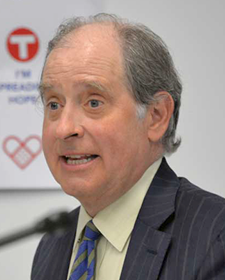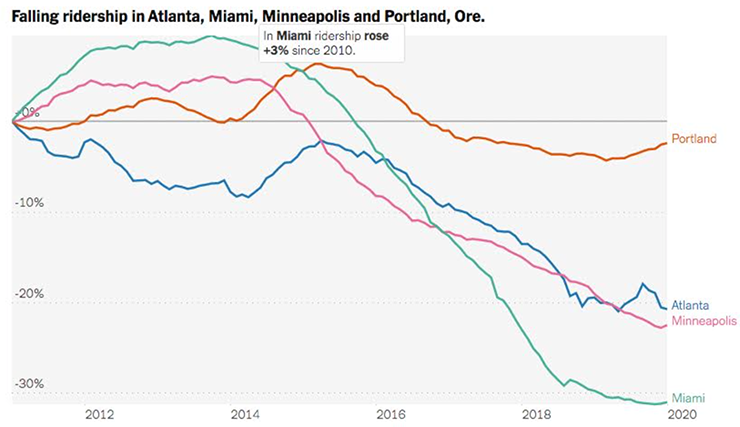When COP26, the big global climate change summit, wrapped up a few weeks ago, it threw another spotlight on the gap between goals and action. Other than the United Kingdom, no wealthy country has even come close to the goals set out five years ago in the Paris Accords. And despite recent policy ideas floated by the Biden Administration, it’s hard to be optimistic about the United States meeting its climate targets because so much would have to change.
For cities in particular, transportation offers the most intractable climate action challenge.
The transportation sector is the largest source of greenhouse gases in Minnesota, and the fastest growing slice to the pollution pie. Because transportation depends on long-term massive infrastructure and the individual actions of millions of people, it’s hard to change quickly.
But to meaningfully reduce carbon pollution, urban transportation has to pivot fast. During the COP26 conference, a group of cities called C40 Cities pushed collectively for climate action in cities around the world. In one high-profile report, the group declared that, “public transport usage must double in global cities over the next decade.”
Imagine for a moment that this was a legitimate goal, and that city decisionmakers were actually trying to accomplish it. What would it mean to actually double Twin Cities transit ridership in the next ten years? What would have to change?
Fast, frequent, reliable
“It’s pretty basic,” said Sam Rockwell, the Executive Director of the transit-advocacy non-profit, Move Minnesota. “People are going to ride transit if it works well. We have to get real and say that its got to work as well as a car in transit-amenable places. That means it’s fast, really frequent, and reliable.”

“In the Twin Cities, we’re defining ‘high-frequency’ transit as a bus or train every 15 minutes,” Rockwell said. “That’s not what I mean. I mean five minutes max at rush hours. It has to come all the time, because you can go get in your car anytime you want.”
Doubling Twin Cities’ ridership would require both short-term and big-picture thinking, or what Rockwell describes as a two-step process. There’s things that can be done right away, and other things that would take a bit longer. In the short-term category, he’s a big fan of dedicated bus lanes.
“In the next two years, we should paint 50 miles of bus lanes,” said Rockwell, pointing to the new red-striped bus lanes on 7th Street in downtown Minneapolis. “It’s not like this is pie-in-the-sky stuff. This is exactly in line with what other cities are doing, at the speed they’re doing it.”
For example, building off its pioneering new bus-only routes on 14th Street in Manhattan, New York City just announced it is striping 20 miles of bus-only lanes in 2022.
“We are just not doing it [and] we need to get serious,” said Rockwell. “we need dedicated street space for transit, explicit bus lanes so they can move really quickly, and so there’s a visual cue to people that we’re prioritizing transit.”
Rockwell is also a big fan of transit signal priority, where stoplights change to green when a bus is approaching. So far that’s been a challenge for local transit routes, including many intersections along the Green Line. But Metro Transit is contemplating some signal prioritization along future arterial Bus Rapid Transit corridors, such as the B Line planned for Lake Street and Marshall Avenue.
“In years three, four and five, we should really double down on the Bus Rapid Transit capital build-outs,” said Rockwell, referring to the Metro Transit’s ambitious aBRT system plans. “Those take a little longer: you have to buy the buses. [But] it’s ridiculous we’re not doing this. These are really low-hanging fruit.”

Rockwell estimates that a buildout of a system like that would cost just over $6 billion, or roughly triple the current cost of the Green Line light rail extension currently under construction. That’s a big number relative to past transit investments.
Short-term and long-term barriers
The $6 billion estimate is an interesting number because it’s almost exactly the amount of money Minnesota is receiving in the just-passed Federal Infrastructure bill. The problem is that only $818 million of that money is going to transit. While that’s still a great start, the bulk of the spending will send $4.8 billion to MnDOT for highways and bridges.
That discrepancy shows the hurdles to systemic change of the type that climate advocates say we need. Our unstable political system is typically poised to favor short-term projects and ribbon-cutting. Meanwhile, the polarization in state and federal governments means that changes made by one administration or legislature are often quickly reversed by the next.

Meanwhile, Metro Transit is experiencing a crisis. Even before the COVID pandemic, ridership was falling nationwide and locally due to a decrease in gas prices. After COVID, ridership has cratered along many routes, and the bounce-back is proving to be difficult on multiple levels. Due to ongoing staffing shortages, Metro Transit is about to make their biggest service cuts in decades.

“At this point people don’t have a real transit choice,” said Rockwell, describing the plight of most people in the Twin Cities. “People can get in their car if they can afford one, or get on the bus and it takes five times as long to get anywhere, and you never get to see your kids. It’s certainly not a choice anyone would hold up as a great vision for our community.”


0 Commentaires